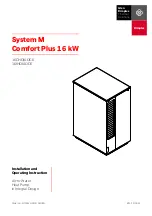
7
SHURflo Operating Instructions, Performance,
Specifications and Parts Manual
Models NG7V, NG11V, NG7V-PH and NG11V-PH
Form L-4092 (3/10)
remaining air to be driven from the
seal chamber and will ensure liquid
circulation to the mechanical seal.
2. Gear pumps are built to very close
tolerances and this tolerance must
not be altered. The liquids must,
therefore, be free of all abrasives.
Sand, silt, wettable powders, etc.
must be avoided.
NOTE:
Cast iron pumps are for oil-based
fluids only.
3. When pumping a more viscous
(beyond 100 SSU on standard mod-
ules) liquid; a slower speed, a larger
pipe size pump, and possibly a
larger motor should be selected.
NOTE:
See performance chart for Max.
Torque.
4. Recheck motor and pump rotation.
Proper pump rotation is clockwise
(CW) looking at the front of the
pump when pressure relief valve
is installed by manufacturer
(See Figure 1).
5. On all standard models, pressure
relief valve is always on discharge
side (See Figure 1).
PRESSURE RELIEF VALVE
6. Standard model rotary gear pumps
are supplied with a built-in internal
pressure relief valve (can be exter-
nally ported). The valve may be
adjusted and used to set system
operating pressure, or used as a
system pressure relief valve to
prevent pump and motor damage
that can occur when discharge line
is closed off. This relief valve is not
factory set. Extended operation
(over one minute) under shut-off
conditions could cause pump to
overheat, leak, and damage itself
or overload motor.
7. To increase the pressure relief valve
pressure setting, remove cap (See
Figure 3 & 13, Ref. No. 31), then
loosen lock nut (See Figure 13, Ref.
No. 36), then turn the set screw
(See Figure 13, Ref. No. 32) in
(clockwise). Turning the set screw
out (counterclockwise) will reduce
the pressure setting. When desired
pressure is achieved, tighten lock
nut and reinstall protective cap (See
Figure 3).
8. The pressure relief valve can be
converted to an external relief. This
will allow the relief to dump back
to tank and allow longer periods of
relief without pump damage.
However, this is not a full-line
pressure relief valve, and in cases
where frequent extended pressure
relief valve operation is anticipated, a
full-line external pressure relief valve
should be piped in the discharge line
and connected either back to the
tank or well down-stream of the
pump suction inlet (See Figure 4).
9. To convert the pressure relief valve
to external relief, remove the NPT
pipe plug from the pump cover
(See Figure 13, Ref. No. 35) and
discard. This plug is next to the
pressure relief valve. In the bottom
of the NPT hole, there is a second
drilled and tapped hole. An
optional external bypass plug (See
Figure 13, Ref. No. 38 included)
should be inserted in this hole and
bottomed out. The open NPT port
must now be piped back to the tank
or well downstream of the pump
suction (See Figure 4).
10. Standard models are equipped with
pressure relief valves, and the pump
can be run in reverse, however,
the pressure relief valve will not
function. For continuous reverse
rotation, the cover plate must be
rotated 180˚ and gears reversed
(See Figure 13). This is accomplished
by removing the eight cover plate
screws, rotating the cover plate,
and reattaching the screws. The
pressure relief valve should now
be on the opposite side. This will
allow operation of the pump with
a functioning pressure relief valve
in reverse rotation. See Maintenance
Pump Repair section for disassembly
and reassembly instructions.
MECHANICAL SEAL FLUSH
INSTALLATION OPTIONS
11. These pumps are equipped with
mechanical seals and have been
designed with flush ports because
mechanical seals require cooling
lubrication for long life.
a. For fluids with viscosities less than
2000 SSU, a flush is not necessary,
but the seal cavity must be pre-
filled with either the operating
fluid or a neutral fluid. This is to
ensure seal cooling and lubrication
during start-up (See Figure 2).
Failure to provide
initial seal prime can
result in the mechanical seal overheating
with resulting repair costs.
Figure 3 - Pressure Relief Valve Adjustment
Loosen valve lock nut and adjust
pressure with adjustment screw
and tighten lock nut again.
Cap
Figure 4 - External Pressure
Relief Valve Installation
Remove external bypass
plug cover and discard.
then insert external bypass
relief plug as shown.


































